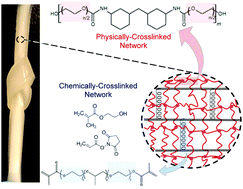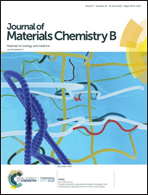Tough hydrophilic polyurethane-based hydrogels with mechanical properties similar to human soft tissues†
Abstract
Biocompatible tough hydrogels are ideal for the fabrication of flexible medical devices such as prosthetics. However, control over the mechanical properties of hydrogels without compromising other characteristics is challenging. This study reports on the fabrication of a series of biocompatible tough hydrogels based on an interpenetrating network system with changeable swelling and mechanical properties via adjusting the chemical structure of each of the networks of the hydrogels. The hydrogels are fabricated from a physically crosslinked poly(ethylene glycol)-based polyurethane and a copolymer that is chemically crosslinked with poly(ethylene glycol)-based crosslinkers. It is found that the chain length of the chemical crosslinkers in the copolymer network and also the chain length of the hydrophilic soft segments in the physically crosslinked polyurethane have significant effects on physico-chemical properties of the hydrogels, determining their swelling, stiffness, strength, and toughness. Altering the size of the chemical crosslinkers or soft segments, respectively, in the chemical and physical networks diversifies the physical and mechanical properties of these hydrogels with toughness within the range of 320–1256 J m−2, stiffness from 263 to 1816 kPa, and strength of 75–813 kPa. Additionally, in vitro cell studies on these hydrogels confirm their biocompatibility. This library of hydrogels offers mechanical properties similar to human soft tissues along with biocompatibility and has potential to be used in the fabrication of medical devices and soft robotics.



 Please wait while we load your content...
Please wait while we load your content...